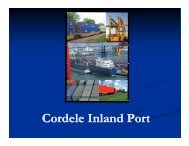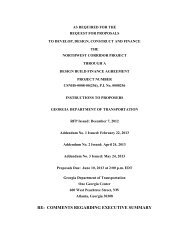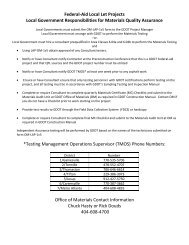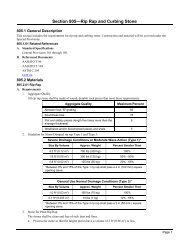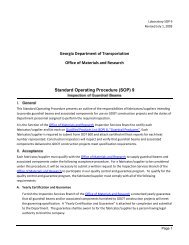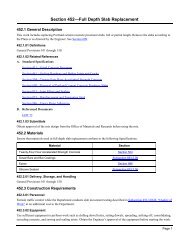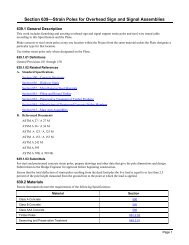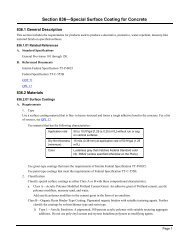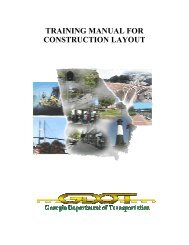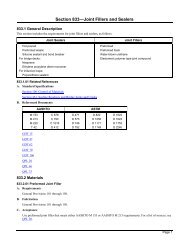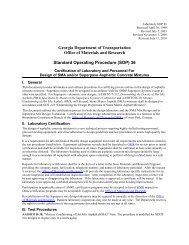Section 533 Bridge Deck Waterproofing Membrane
Section 533 Bridge Deck Waterproofing Membrane
Section 533 Bridge Deck Waterproofing Membrane
You also want an ePaper? Increase the reach of your titles
YUMPU automatically turns print PDFs into web optimized ePapers that Google loves.
<strong>533</strong>.1 General Description<br />
<strong>Section</strong> <strong>533</strong>—<strong>Bridge</strong> <strong>Deck</strong> <strong>Waterproofing</strong> <strong>Membrane</strong><br />
This work consists of preparing surfaces for and applying a protective membrane to concrete bridge decks. The membrane<br />
shall serve as a waterproof barrier to be overlaid with asphaltic concrete.<br />
The waterproofing method shall be as specified on the Plans and shall be one of the following:<br />
<strong>533</strong>.1.01 Definitions<br />
Method A: A waterproofing membrane system placed directly on the Portland cement concrete bridge deck<br />
surface.<br />
Method B: A waterproofing membrane system placed directly on a specified grade and thickness of freshly<br />
placed asphaltic concrete on the bridge deck.<br />
General Provisions 101 through 150.<br />
<strong>533</strong>.1.02 Related References<br />
A. Standard Specifications<br />
<strong>Section</strong> 400—Hot Mix Asphaltic Concrete Construction<br />
<strong>Section</strong> 413—Bituminous Tack Coat<br />
<strong>Section</strong> 500—Concrete Structures<br />
B. Referenced Documents<br />
General Provisions 101 through 150.<br />
<strong>533</strong>.1.03 Submittals<br />
General Provisions 101 through 150.<br />
<strong>533</strong>.2 Materials<br />
All materials shall meet the requirements of the following specifications:<br />
Material<br />
<strong>Section</strong><br />
Asphaltic Concrete 400<br />
Bituminous Prime 412<br />
Bituminous Tack Coat 413<br />
Sand for Blast Cleaning 804<br />
<strong>Waterproofing</strong> <strong>Membrane</strong> Materials 888.2.01<br />
Mortar 834.2.03<br />
For a list of sources, see QPL 22.<br />
<strong>533</strong>.2.01 Delivery, Storage, and Handling<br />
General Provisions 101 through 150.<br />
<strong>533</strong>.3 Construction Requirements<br />
<strong>533</strong>.3.01 Personnel<br />
General Provisions 101 through 150.<br />
Page 1
<strong>Section</strong> <strong>533</strong>—<strong>Bridge</strong> <strong>Deck</strong> <strong>Waterproofing</strong> <strong>Membrane</strong><br />
<strong>533</strong>.3.02 Equipment<br />
General Provisions 101 through 150.<br />
<strong>533</strong>.3.03 Preparation<br />
A. Method A Surface Preparation<br />
Cure new bridge decks that will receive waterproofing membrane according to Subsection 500.3.05.Z, “Cure Concrete”<br />
without using membrane-forming curing compounds or linseed oil treatments.<br />
Prepare concrete surfaces receiving Method A waterproofing as follows:<br />
1. Chip or grind smooth high spots, sharp points, and edges on the deck surface.<br />
2. Fill holes and depressions in the concrete surface flush with mortar.<br />
Mortar shall be composed of one part Portland Cement and two parts sand and shall be cured according to<br />
Subsection 500.3.05.Z, “Cure Concrete”.<br />
Approved, commercially produced, fast setting grout may be used to expedite the Work.<br />
3. Allow the mortar to cure.<br />
4. Clean and remove all traffic paint and other harmful materials from the deck by sand-blasting the entire deck surface<br />
to which the waterproofing membrane will be applied.<br />
5. Remove all sand-blasting residue with compressed air. Do not use water to clean the deck.<br />
B. Method B Surface Preparation<br />
Prepare concrete surfaces receiving Method B waterproofing as follows:<br />
1. Prepare the Joints<br />
When the Plans specify to place the waterproofing membrane continuously across any joint, prepare the joints as<br />
follows before applying the asphaltic concrete:<br />
a. Place an additional strip of preformed sheet membrane transversely across deck joints. This strip shall have a<br />
minimum width of 18 in (450 mm) and shall be centered across the joint.<br />
b. Apply a mastic (of the type specified by the manufacturer) at the face of the curb and at joints to ensure that the<br />
membrane uniformly adheres to the concrete.<br />
2. Apply the Asphaltic Concrete<br />
Once the joints have been prepared, apply the asphaltic concrete as follows:<br />
a. Apply a tack coat to the bridge deck at the rate specified by the Engineer.<br />
b. Place the specified grade and thickness of asphaltic concrete.<br />
c. Compact the asphaltic concrete according to the applicable provisions of <strong>Section</strong> 400.<br />
<strong>533</strong>.3.04 Fabrication<br />
General Provisions 101 through 150.<br />
<strong>533</strong>.3.05 Construction<br />
A. Method A <strong>Waterproofing</strong><br />
Use the following guidelines when waterproofing by Method A:<br />
1. Observe Weather Conditions<br />
Do not perform the work when the relative humidity is above 80 percent or when rain is imminent.<br />
Prime surfaces and place membrane only when the air and concrete surface temperatures are above 50 °F (10 °C)<br />
and the surface is thoroughly dry.<br />
Page 2
<strong>Section</strong> <strong>533</strong>—<strong>Bridge</strong> <strong>Deck</strong> <strong>Waterproofing</strong> <strong>Membrane</strong><br />
2. Prime the Surface<br />
Prime the surface as follows:<br />
a. Ensure that the concrete decks are at least 14 days old before applying prime and membrane.<br />
b. Prime and cure all areas that will receive membrane according to the manufacturer’s recommendation or as<br />
directed by the Engineer.<br />
3. Place the <strong>Waterproofing</strong> <strong>Membrane</strong><br />
Place the waterproofing membrane as follows:<br />
a. Unless otherwise designated on the Plans, extend the waterproofing membrane at least 6 in (150 mm) up the<br />
faces of the curbs, parapets, and barriers in the transverse direction and to the outer limits of the approach slabs<br />
in the longitudinal direction.<br />
b. Apply the membrane to the deck surface using either hand methods or mechanical applicators.<br />
c. Apply the membrane to the concrete deck so that it forms a butt joint with the faces of open joints and at<br />
expansion devices and other joints.<br />
d. Seal the edges of the membrane and the drain openings to prevent water from passing between the<br />
waterproofing and the surface it covers.<br />
e. Install preformed sheet membrane in a shingled pattern so that water can drain to the low areas of the deck<br />
without accumulating against seams. Follow these steps to install the membrane:<br />
1) Roll the preformed sheet membrane into place with a lawn-type roller to minimize air bubbles and to<br />
ensure that the membrane bonds with the primed surface and bonds at the overlaps.<br />
2) Overlap each strip of preformed sheet membrane at least 4 in (100 mm).<br />
3) Place the membrane so that end laps are in the direction of the paving operation.<br />
4) When the Plans indicate to place the waterproofing membrane continuously across any joint, prepare the<br />
joints as described in <strong>Section</strong> <strong>533</strong>.3.03.B.1.<br />
f. Eliminate air bubbles by puncturing the membrane and forcing the air out.<br />
g. Repair these holes and other ruptures as recommended by the manufacturer. Extend patches at least 6 in (150<br />
mm) beyond the defect.<br />
h. Completely open all drain holes in the deck before paving over them.<br />
4. Place the Pavement<br />
Place the pavement as follows:<br />
a. Do not allow construction traffic over the waterproofing membrane before placing the surface pavement.<br />
b. Apply the paving over the membrane.<br />
c. Completely open drain holes in the deck after placing the pavement course.<br />
B. Method B <strong>Waterproofing</strong><br />
After the asphaltic concrete is compacted and water used in the compaction process has dried completely, place<br />
waterproofing membrane directly on the asphaltic concrete using the methods specified in Method A <strong>Waterproofing</strong> with<br />
the following exception:<br />
The tack coat or primer is not required on the asphaltic concrete beneath the waterproofing membrane.<br />
C. Method A and Method B Applying Bituminous Overlay<br />
The paving operation and asphaltic concrete temperatures shall comply with the membrane manufacturer’s<br />
recommendations and the applicable asphalt concrete pavement Specifications, or be as directed by the Engineer.<br />
Only vehicles necessary for the overlay or paving operations shall be on the membrane.<br />
Page 3
<strong>Section</strong> <strong>533</strong>—<strong>Bridge</strong> <strong>Deck</strong> <strong>Waterproofing</strong> <strong>Membrane</strong><br />
The Contractor shall be responsible for maintaining the condition of the waterproofing membrane until it is covered with<br />
pavement.<br />
Apply bituminous overlay in either Method A or Method B as follows:<br />
1. Before placing the overlay and if required, apply a bond coat of adhesive (bituminous tack coat) to the surface of the<br />
waterproofing membrane according to the membrane manufacturer’s recommendations.<br />
2. Overlay the waterproofing membrane with the thickness or quantity and the type of asphaltic concrete specified on<br />
the Plans.<br />
Bituminous overlay application shall begin as soon as possible after the membrane and, if required, after the bond<br />
coat are placed.<br />
3. Dump the asphalt concrete directly into the receiving hopper of the paving machine.<br />
4. Have the truck pull forward and avoid contacting the paving machine while it is moving.<br />
5. Do not permit the mixture to be dumped onto the deck ahead of the paving machine.<br />
6. Spread and roll the asphalt concrete so that the membrane will not be damaged. Roll the first asphalt concrete lift<br />
with a breakdown roller as soon as possible after the paving machine has passed. Do not permit the use of vibratory<br />
rollers with the vibrator on.<br />
7. Since a minimum percent compaction is not specified, compact the asphaltic concrete to the satisfaction of the<br />
Engineer and applicable compaction requirements in Subsection 400.3.06.C.<br />
8. Place a final surface course of Open Graded Surface Mixture according to Subsection 828.2.01, “Open Graded<br />
Surface Mixtures” in the amount specified on the Plans unless otherwise specified.<br />
<strong>533</strong>.3.06 Quality Acceptance<br />
General Provisions 101 through 150.<br />
<strong>533</strong>.3.07 Contractor Warranty and Maintenance<br />
General Provisions 101 through 150.<br />
<strong>533</strong>.4 Measurement<br />
<strong>Bridge</strong> deck waterproofing membrane, complete in place and accepted, will be measured by the number of square yards<br />
(meters) of bridge deck and approach slabs covered. Material placed on curb faces and overlaps will not be measured.<br />
Tack coat and asphaltic concrete will be measured and paid for as provided under the respective Items of <strong>Section</strong> 400 and<br />
<strong>Section</strong> 413.<br />
<strong>533</strong>.4.01 Limits<br />
General Provisions 101 through 150.<br />
<strong>533</strong>.5 Payment<br />
<strong>Bridge</strong> deck waterproofing membrane will be paid for at the Contract Unit Price per square yards (meters) for preparing the<br />
surfaces and for furnishing and applying the waterproofing system.<br />
Payment will be made under:<br />
Item No. <strong>533</strong> <strong>Bridge</strong> deck waterproofing membrane (method____) Per square yard (meter)<br />
<strong>533</strong>.5.01 Adjustments<br />
General Provisions 101 through 150.<br />
Page 4



